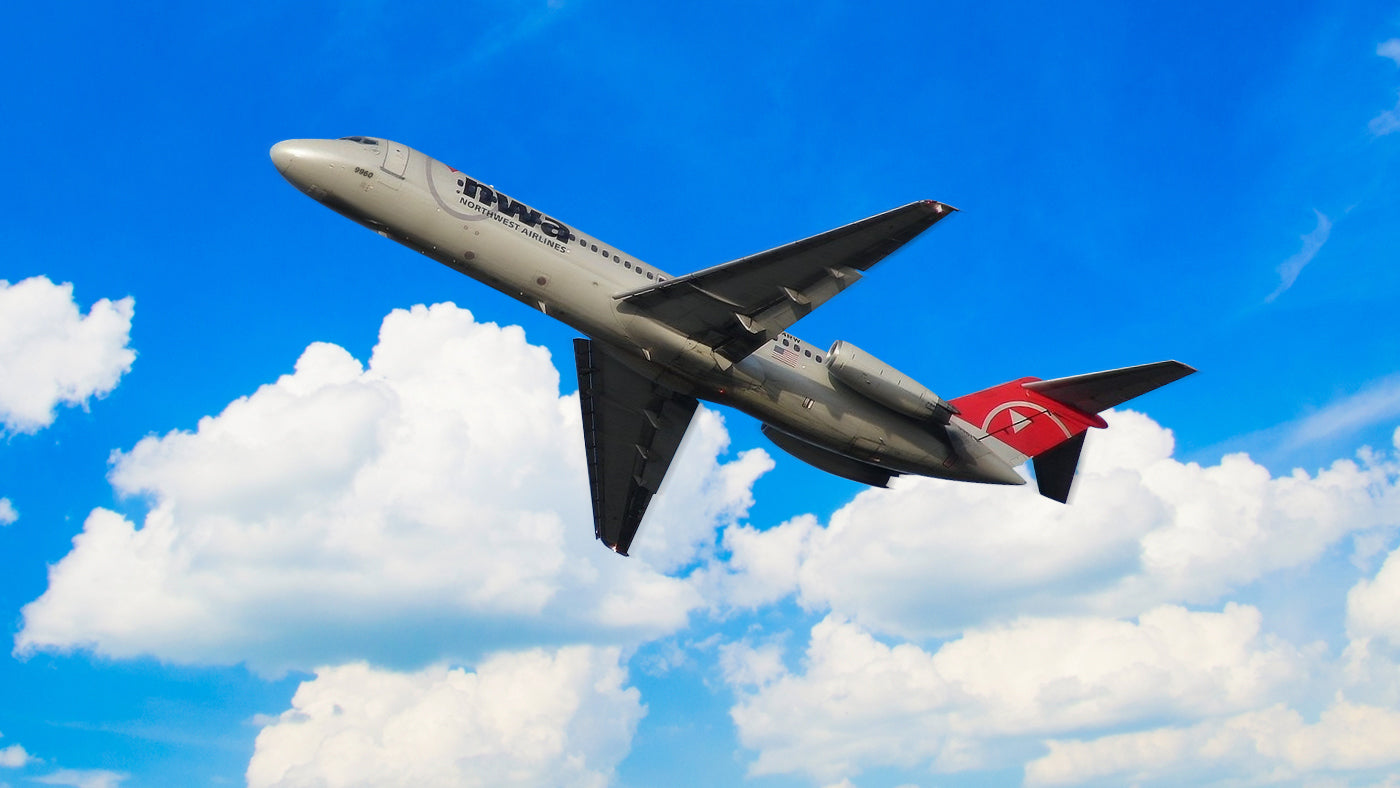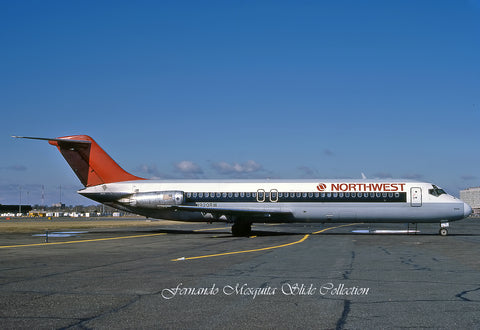
- by Dianna Lopez
DC-9: Northwest Airlines Iconic Workhorse
- by Dianna Lopez
A question? Visit our contact page
This site uses cookies for better user experience and analytics.

The McDonnell Douglas DC-9's legacy is undeniable, with nearly one thousand units of the popular aircraft produced during its 17 year manufacturing run. The DC-9's impact on the aviation industry remains significant, serving as a testament to its enduring design and the innovative spirit of McDonnell Douglas. N920RW, a DC-9-31, was one of 976 DC-9s built, serving some of the notable U.S. domestic carriers of its era, including Northwest Airlines. Learn more about N920RW and Northwest Airlines DC-9 PlaneTags.
Developed in the 1960s by the American aerospace manufacturer McDonnell Douglas, the twin-engine DC-9 was designed as a short- to medium-range aircraft suitable for both passenger and cargo operations. The DC-9 entered service on December 8, 1965, and quickly gained popularity among airlines worldwide due to its versatility, reliability, and efficiency. Its production years ran until 1982, producing 976 units.

Douglas, DC-9 flickr photo by San Diego Air & Space Museum Archives shared with no copyright restriction (Flickr Commons)
One of the standout features of the DC-9 was its distinctive T-tail configuration, wherein the horizontal stabilizer is mounted on top of the vertical fin. This design allowed for improved stability and reduced interference from engine exhaust, which contributed to enhanced performance and fuel efficiency. With its spacious cabin and excellent performance capabilities, the DC-9 proved to be an ideal choice for airlines operating regional and medium-haul routes. Its ability to take off and land on shorter runways made it well-suited for smaller airports and city-to-city connections. Furthermore, the aircraft's durability and low operating costs made it an attractive option for both established carriers and emerging airlines around the world.
Over the course of its production, the DC-9 underwent several advancements and upgrades, resulting in improved versions such as the DC-9 Super 80 and the MD-80 series. These iterations featured more powerful engines, increased seating capacities, and enhanced avionics, ensuring the aircraft remained competitive in a rapidly evolving market. The DC-9's success also led to the development of the larger McDonnell Douglas MD-90 and MD-95/Boeing 717 aircraft, which shared many of its design elements.

Here is a list of the major DC-9 variants, including the MD-80, and MD-90 generations, which shared a common lineage with the DC-9.
Also derived from the DC-9:

S/n 47163, built as a DC-9-31 at the Douglas Aircraft plant in Long Beach, California, took its first flight on January 12, 1968. Registered as N8940E, it was delivered to Eastern Air Lines on February 15, 1968 and served the airline until 1977. Eastern was the first airline to put the DC-9-30 into service. During its history, EAL had 123 DC-9 planes, 82 of which were DC-9-30 variants.

Purchased by Hughes Airwest in 1977, the plane was registered as N920RW and remained with the airline through troubled times, including a walkout in September 1979 and a buyout a year later by Republic Airlines.

After the merger with Hughes Airwest, Republic Airlines became the largest U.S. airline, based on the number of airports served. Republic also operated the largest DC-9 fleet in the world, with 133 DC-9s in three variants, as well as Boeing 727-200, Boeing 757-200, McDonnell Douglas MD-80, and Convair 580. However, in debt from its airline and new plane acquisitions, they began reducing service along their former extensive route system. Six years after the Hughes merger, on October 1, 1986, Republic merged with Northwest Airlines in the largest merger at the time. N920RW put on the Northwest colors, accumulating a total of 96,653 flight hours before retiring in 2005.

Northwest Airlines was a major American airline with a rich history that spanned over eight decades. It was founded in 1926 as Northwest Airways and initially operated as a U.S.Midwest regional carrier. Over the years, Northwest Airlines grew in size and scope, expanding its route network and becoming a prominent player in the airline industry.
During the 1980s and 1990s, Northwest Airlines underwent significant changes and transformations. It embraced the jet age, retiring its propeller-driven aircraft and introducing modern jetliners like the Boeing 747 and McDonnell Douglas DC-10. NWA also expanded its international operations, establishing itself as a global carrier with an extensive network connecting North America to Asia, Europe, and other destinations around the world. Its merger with Republic Airlines in 1986 further strengthened Northwest's presence, including a new hub in Minneapolis-St. Paul, which became one of the airline's primary connecting points and allowed it to expand its reach in the U.S.

However, Northwest Airlines faced significant challenges in the early 2000s, including financial difficulties and the aftermath of the September 11 attacks. In an effort to remain competitive and ensure its long-term viability, the airline began discussions of a merger with Delta Air Lines. In 2008, Northwest Airlines and Delta Air Lines announced their intention to merge, creating one of the largest airlines in the world. The merger was completed in 2010, with the new entity operating under the name Delta Air Lines. The merger brought together two well-established carriers with complementary route networks, allowing for expanded global connectivity and improved operational efficiencies. Although this merger marked the end of Northwest Airlines as a distinct brand, its legacy included developing transpacific routes and establishing connections between the United States and Asia.

"Finding a Northwest DC-9 has always been on my list of must-haves, and I'm sure on the lists of many PlaneTags collectors too," says MotoArt owner Dave Hall. "It was a familiar sight in the sky for many of us growing up so it's pretty cool having one to collect or travel with now."










The DC-9 PlaneTags are numbered in a series of 7500 and will initially be available in the following colors:






The DC-9s will be released on Thursday, June 8th at 12pm PT. Northwest Airlines DC 9 PlaneTags are an essential need for any aviation fanatic’s tag collection. Be sure to grab the colors you want before they are sold out.
From Warbird to Water Bomber: The Epic Life of the Hawaii Mars
In the world of aviation, few aircraft have lived a life as large, or as long, as the Hawaii Mars. Towering over most of its contemporaries with a wingspan of 200 feet, this mighty flying boat was born in the final days of World War II, then quietly transformed into one of the most iconic aerial firefighting aircraft the world has ever seen. From military transport to firefighting titan, the Hawaii Mars represents one of aviation’s most extraordinary second acts.
In 2025, MotoArt obtained an original wing of this aircraft and created special PlaneTags, made exclusively for the Martin family members and Mars workers. On December 11, 2025, Hawaii Mars PlaneTags will be available to the general public for the first time.
F-14 Tomcat Coasters: A Legendary Fighter Reimagined for Your Home
Few aircraft define an era quite like the Grumman F-14 Tomcat. Sleek, powerful, and unmistakably iconic, the Tomcat was the Navy’s premier fleet defense fighter for more than three decades. From Cold War missions to pop culture stardom, the F-14 remains one of the most recognizable and beloved aircraft ever built. Today, MotoArt is proud to introduce the F-14 Tomcat Coaster Set, created from authentic F-14 aircraft material.
PR-AJB: The Story of an Azul Airbus A320 With a Global Journey
Every airplane has a story, and some travel farther than others before their flying days are over. PR-AJB was one of those well-traveled aircraft. This Airbus A320 started its life flying British families on long-awaited holidays, then later crossed the Atlantic to join the growing fleet of Azul Linhas Aéreas Brasileiras. Over nearly nineteen years it picked up new registrations, new paint, new routes and a new home, carrying thousands of passengers along the way.
Its journey reflects how widely the A320 family has spread around the world and how easily these aircraft adapt to whatever their next chapter requires. PR-AJB also arrived at Azul during an important period of expansion as the airline worked to connect more cities across Brazil. In this blog we will explore where the aircraft came from, what it did during its short time with Azul, and how it eventually came to rest in Florida. We will also share how MotoArt recovered material from the retired airframe and created PlaneTags so its story can continue in a new way.


Share:
Aviation Gifts: Gift Ideas For Dads
MD 530 F: The Ultimate Helicopter for Multiple Missions